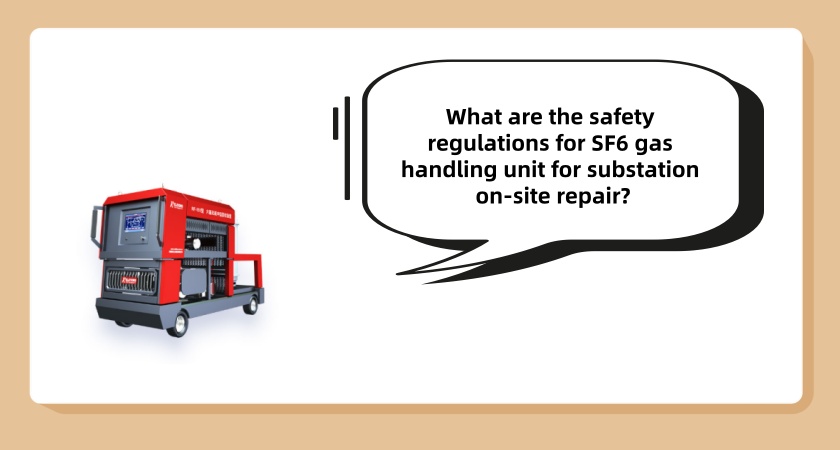Safety regulations for SF6 gas handling units during substation on-site repair are governed by international, national, and industry-specific standards to ensure personnel safety, equipment integrity, and environmental protection. Below is a comprehensive breakdown based on key regulations and best practices:
1. Personnel Safety Requirements
Protective Equipment
Respiratory Protection: Use positive-pressure air respirators (e.g., NIOSH-approved) when handling leaked or decomposed SF6, as it may contain toxic byproducts like HF and SO₂ .
Personal Protective Gear (PPE): Wear acid-resistant gloves, anti-static overalls, and safety goggles to prevent skin/eye contact with corrosive gases .
Training and Certification: Operators must complete specialized training on SF6 properties, handling procedures, and emergency protocols (per IEC 62271-4 and DL/T 639) .
Work Environment
Ventilation: Ensure well-ventilated work areas. For indoor repairs, install SF6/O₂ monitors with alarms (SF6 ≥1000 ppm, O₂ ≤19.5%) and automatic exhaust systems .
Entry Restrictions: Prohibit unauthorized personnel from the work zone. Avoid solo repairs in confined spaces (e.g., GIS rooms) .
2. Equipment Safety Standards
Handling Unit Specifications
Explosion-Proof Design: Use units with flame-retardant materials, spark-proof components, and overpressure protection (automatic shutdown at ≥12 MPa) .
Leakage Prevention: Employ double-seal connections (O-rings + metal gaskets) and fluorine-resistant hoses (pressure rating ≥6 MPa). Conduct helium leak tests annually .
Vacuum Capability: Units must achieve ≤10 Pa ultimate vacuum to ensure thorough gas extraction and prevent air contamination .
Storage and Transportation
Cylinder Compliance: Store SF6 in seamless steel cylinders (rated pressure ≥15 MPa) marked "SF6" with hydrostatic testing every 3 years (GB 5099) .
Transport Safety: Secure cylinders upright during transit, away from heat and flammable materials. Use dedicated trailers for bulk transport .
3. Operational Procedures
Pre-Repair Checks
Gas Quality Verification: Test new SF6 for purity (≥99.9%), moisture (≤60 μL/L), and decomposition products (SO₂, HF ≤0.5 μL/L) using a portable analyzer .
Equipment Preparation: Evacuate the substation equipment to ≤133 Pa and maintain for ≥30 minutes before connecting the handling unit .
Gas Recovery and Purification
Recovery Efficiency: Achieve ≥95% SF6 recovery rate (DL/T 1555-2016). Use compression-cooling (0–5°C) to liquefy gas into storage cylinders .
Purification Process: Remove moisture (≤30 μL/L), oil (≤5 ppm), and solid particles (≤0.1 μm) via molecular sieves, alkaline filters, and precision filtration .
Re-Injection and Disposal
Re-Injection Protocol: Refill equipment at ≤0.1 MPa/min to prevent liquefaction. Verify pressure/temperature stability post-injection .
Waste Disposal: Entrust non-recyclable SF6 to certified facilities for thermal decomposition (1200–1500°C) or chemical treatment (e.g., reaction with AlF₃). Direct emission is strictly prohibited climate.ec.europa.eu.
4. Environmental Compliance
Emission Control
Regulatory Limits: Adhere to EU F-Gas Regulation (517/2014), which mandates a 67% reduction in F-gas emissions by 2030. In China, follow DL/T 1555-2016 for leak detection and recovery climate.ec.europa.eu.
Reporting: Submit annual SF6 emission reports to local environmental authorities, including gas usage, recovery, and disposal data .
Waste Management
Adsorbent Handling: Dispose of spent molecular sieves and alkaline filters in 20% NaOH solution for 12 hours before landfill .
Contaminated Materials: Clean equipment surfaces with acetone or ethanol to remove decomposition residues .
5. Monitoring and Maintenance
Real-Time Detection
Fixed Sensors: Install wall-mounted SF6/O₂ detectors in substation rooms with audible/visual alarms and remote data logging (DL/T 1555-2016) .
Portable Tools: Use handheld leak detectors (detection limit ≤1 ppm) for daily patrols of flange connections and valves .
Preventive Maintenance
Daily Checks: Inspect hoses, seals, and pressure gauges for wear. Replace defective components immediately .
Annual Overhaul: Service vacuum pumps, compressors, and filters. Calibrate sensors and verify equipment performance against IEC 62271-4 .
6. Emergency Protocols
Leak Response: Evacuate personnel, activate exhaust systems, and use recovery units to contain leaks. Avoid entry without PPE until concentrations drop below 1000 ppm .
Spill Cleanup: Neutralize spilled SF6 decomposition products with baking soda or lime. Dispose of contaminated soil in sealed containers .
First Aid: If exposed, remove contaminated clothing, rinse skin/eyes with water for 15 minutes, and seek medical attention .
Key Regulatory References
| Standard | Scope |
|---|
| IEC 62271-4 | International guidelines for SF6 handling during installation, repair, and disposal . |
| DL/T 1555-2016 | Chinese standard for SF6 leak monitoring, recovery, and purification . |
| EU F-Gas Regulation | Emission reduction targets and recovery obligations climate.ec.europa.eu. |
| GB/T 12022-2015 | SF6 quality specifications for industrial use . |
| OSHA 1910.1000 | U.S. workplace safety standards for hazardous gases . |
Compliance with these regulations ensures safe, efficient, and environmentally responsible SF6 handling during substation repairs. Prioritize training, equipment maintenance, and real-time monitoring to minimize risks and meet global sustainability goals. Always refer to the latest editions of standards and consult certified experts for complex repairs.


Leave A Message
Your email address will not be published. Required fields are marked *